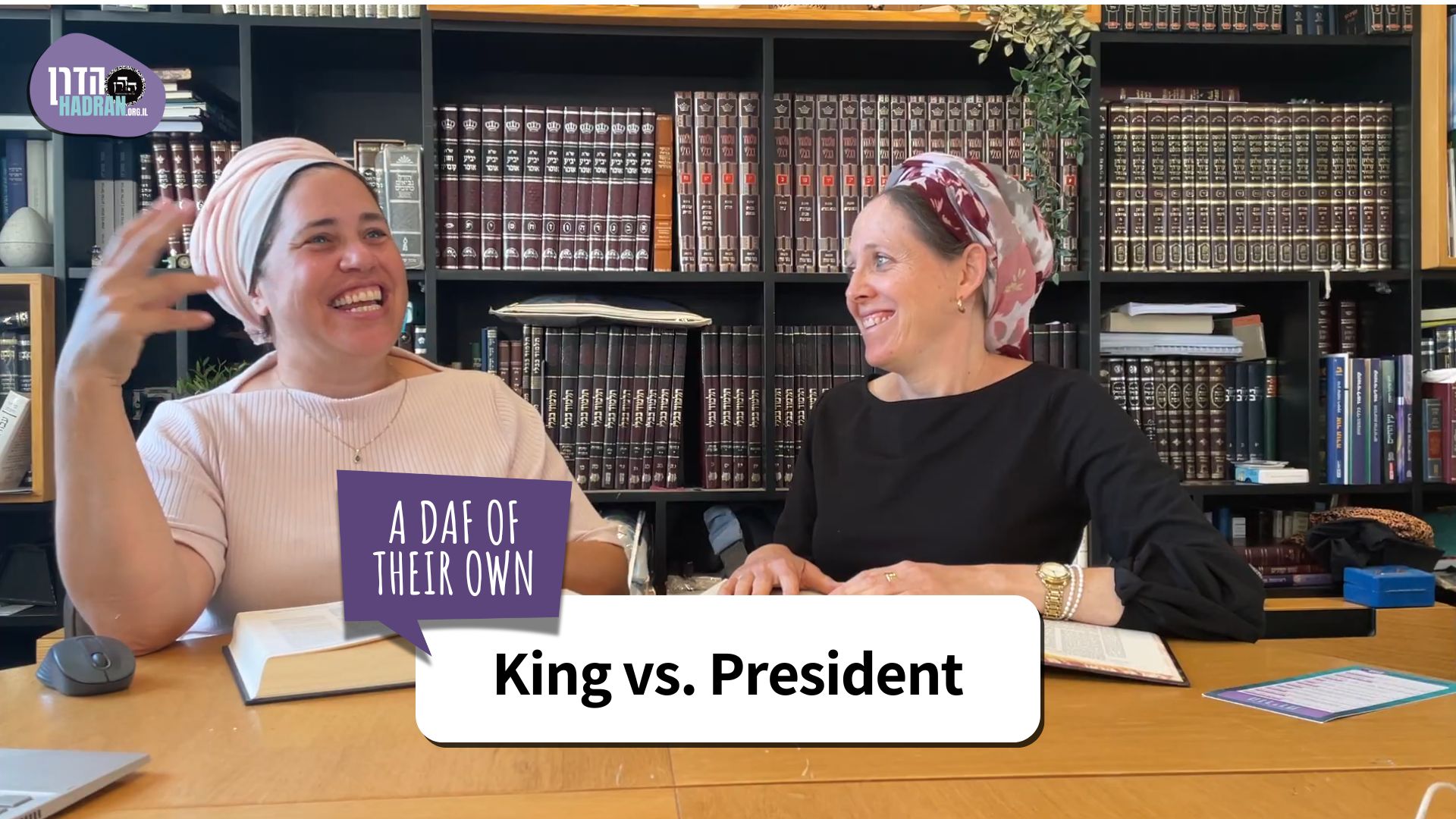What are the four domains? What is an eruv? What does it permit? What is a lechi, kora, tzurat hapetach? What is the maximum height of a kora, beam and the maximum width of the opening of the alley (mavoi)? The rabbis and Rabbi Yehuda have different opinions. The gemara compares our mishna to the first mishna in Sukka and question why the language used is different. Rav says that both measurement s of the rabbis and Rabbi Yehuda are learned from the measurements of the Temple – one from the entranceway to the ulam, antechamber and one from the entranceway to the heichal, sanctuary. They are both derived from verses relating to the tabernacle. How can we learn about the temple from the tabernacle? And if so, why not from the entranceway to the courtyard of the tabernacle which was wider? The gemara brings several questions on Rav and concludes that Rabbi Yehuda did not learn from the ulam, but learned from palaces of kings.
This week’s learning is sponsored by Helen Danczak. “My dear uncle Phil passed on August 27 with family at hand. He was the kind of uncle that the kids (of all ages) gravitated to. I am not alone in saying he was my favorite uncle. He is missed. May his neshama have an aliyah.”
This week’s learning is dedicated by Medinah Korn in loving memory of her mother, Rosalie Katchen, Shoshana Raizl bat Avraham Yehoshua ve-Baila Toibe, z”l, on her 25th yahrzeit. She left a profound legacy for her family and many devoted friends who continue to learn from her to this day. Yehi zichra baruch.
Want to dedicate learning? Get started here:


This week’s learning is sponsored by Helen Danczak. “My dear uncle Phil passed on August 27 with family at hand. He was the kind of uncle that the kids (of all ages) gravitated to. I am not alone in saying he was my favorite uncle. He is missed. May his neshama have an aliyah.”
This week’s learning is dedicated by Medinah Korn in loving memory of her mother, Rosalie Katchen, Shoshana Raizl bat Avraham Yehoshua ve-Baila Toibe, z”l, on her 25th yahrzeit. She left a profound legacy for her family and many devoted friends who continue to learn from her to this day. Yehi zichra baruch.
Delve Deeper
Broaden your understanding of the topics on this daf with classes and podcasts from top women Talmud scholars.
New to Talmud?
Check out our resources designed to help you navigate a page of Talmud – and study at the pace, level and style that fits you.
The Hadran Women’s Tapestry
Meet the diverse women learning Gemara at Hadran and hear their stories.
Eruvin 2
מָבוֹי שֶׁהוּא גָּבוֹהַּ לְמַעְלָה מֵעֶשְׂרִים אַמָּה — יְמַעֵט. רַבִּי יְהוּדָה אוֹמֵר: אֵינוֹ צָרִיךְ.
MISHNA: If an alleyway is enclosed on three sides with courtyards opening into it from three sides, and the fourth side opens into a public domain, it is prohibited by rabbinic law to carry objects in it on Shabbat. However, carrying in an alleyway under those circumstances is permitted if a cross beam is placed horizontally over the entrance to the alleyway. The mishna teaches that if the cross beam spans the entrance to an alleyway at a height above twenty cubits, one must diminish the height of the cross beam so that it is less than twenty cubits. Rabbi Yehuda says: He need not diminish it, since the cross beam enables one to carry in the alleyway even at that height.
וְהָרָחָב מֵעֶשֶׂר אַמּוֹת יְמַעֵט. וְאִם יֵשׁ לוֹ צוּרַת הַפֶּתַח, אַף עַל פִּי שֶׁהוּא רָחָב מֵעֶשֶׂר אַמּוֹת אֵין צָרִיךְ לְמַעֵט.
If the entrance to the alleyway is wider than ten cubits, one must diminish its width. However, if the entrance to the alleyway has the form of a doorway, i.e., two vertical posts on the two sides, and a horizontal beam spanning the space between them, even if it is wider than ten cubits, he need not diminish it, as it is then regarded as an entrance, rather than a breach, even if it is very wide.
גְּמָ׳ תְּנַן הָתָם: סוּכָּה שֶׁהִיא גְּבוֹהָה לְמַעְלָה מֵעֶשְׂרִים אַמָּה פְּסוּלָה, וְרַבִּי יְהוּדָה מַכְשִׁיר. מַאי שְׁנָא גַּבֵּי סוּכָּה דְּתָנֵי ״פְּסוּלָה״ וְגַבֵּי מָבוֹי תָּנֵי תַּקַּנְתָּא?
GEMARA: We learned in a mishna there, in tractate Sukka: A sukka that is more than twenty cubits high is unfit, and Rabbi Yehuda deems it fit. The halakhot are similar in substance but differ in formulation, and accordingly the Gemara asks: What is the difference that with regard to a sukka the mishna teaches that it is unfit, whereas with regard to an alleyway, it teaches the method of rectification, that one must diminish the height of the cross beam?
סוּכָּה דְּאוֹרָיְיתָא, תָּנֵי ״פְּסוּלָה״. מָבוֹי דְּרַבָּנַן, תָּנֵי תַּקַּנְתָּא.
The Gemara answers: With regard to sukka, since it is a mitzva by Torah law, the mishna teaches that it is unfit, as if it is not constructed in the proper manner, no mitzva is fulfilled. Whereas with regard to an alleyway, where the entire prohibition of carrying is only by rabbinic law, the mishna teaches the method of rectification, as the cross beam comes only to rectify a rabbinic prohibition, but does not involve a mitzva by Torah law.
וְאִיבָּעֵית אֵימָא: דְּאוֹרָיְיתָא נָמֵי תָּנֵי תַּקַּנְתָּא. אֶלָּא, סוּכָּה דִּנְפִישִׁין מִילֵּיהּ — פָּסֵיק וְתָנֵי ״פְּסוּלָה״. מָבוֹי דְּלָא נְפִישִׁי מִילֵּיהּ — תָּנֵי תַּקַּנְתָּא.
The Gemara suggests an alternative explanation: And if you wish, say instead that even with regard to matters prohibited by Torah law, it would have been appropriate for the mishna to teach a method of rectification. However, with regard to sukka, whose matters are numerous, it categorically teaches that it is unfit. Merely diminishing the height of a sukka is insufficient to render it fit; it must also satisfy requirements governing its size, its walls, and its roofing. Teaching the remedy for each disqualification would have required lengthy elaboration. With regard to an alleyway, however, whose matters are not numerous, the mishna teaches the method of rectification. Once the height is diminished, it is permitted to carry in the alleyway.
אָמַר רַב יְהוּדָה אָמַר רַב: חֲכָמִים לֹא לְמָדוּהָ אֶלָּא מִפִּתְחוֹ שֶׁל הֵיכָל, וְרַבִּי יְהוּדָה לֹא לְמָדָהּ אֶלָּא מִפִּתְחוֹ שֶׁל אוּלָם.
Rav Yehuda said that Rav said: The Rabbis only derived this halakha, that an opening more than twenty cubits high is not considered an entrance, from the doorway of the Sanctuary, the inner sanctum of the Temple. And Rabbi Yehuda only derived his opinion, that even an opening more than twenty cubits high is considered an entrance, from the doorway of the Entrance Hall leading into the Sanctuary.
דִּתְנַן: פִּתְחוֹ שֶׁל הֵיכָל גׇּבְהוֹ עֶשְׂרִים אַמָּה וְרׇחְבּוֹ עֶשֶׂר אַמּוֹת, וְשֶׁל אוּלָם גׇּבְהוֹ אַרְבָּעִים אַמָּה וְרׇחְבּוֹ עֶשְׂרִים אַמּוֹת.
As we learned in a mishna: The doorway of the Sanctuary is twenty cubits high and ten cubits wide, and that of the Entrance Hall is forty cubits high and twenty cubits wide.
וּשְׁנֵיהֶן מִקְרָא אֶחָד דָּרְשׁוּ: ״וּשְׁחָטוֹ פֶּתַח אֹהֶל מוֹעֵד״, דְּרַבָּנַן סָבְרִי: קְדוּשַּׁת הֵיכָל לְחוּד וּקְדוּשַּׁת אוּלָם לְחוּד. וְכִי כְּתִיב ״פֶּתַח אֹהֶל מוֹעֵד״ — אַהֵיכָל כְּתִיב.
The Gemara explains the basis of this tannaitic dispute. Both of them, the Rabbis and Rabbi Yehuda, interpreted the same verse homiletically: “And he shall lay his hand upon the head of his offering and slaughter it at the doorway of the Tent of Meeting, and Aaron’s sons, the priests, shall sprinkle the blood on the altar round about” (Leviticus 3:2). As the Rabbis hold that the sanctity of the Sanctuary is discrete and the sanctity of the Entrance Hall is discrete, i.e., the Sanctuary and the Entrance Hall have distinct levels of sanctity. And since the essence of the Temple is the Sanctuary and not the Entrance Hall, and since the Sanctuary in the Temple parallels the Tent of Meeting in the Tabernacle, when the verse speaks of the doorway of the Tent of Meeting, it is referring to the doorway of the Sanctuary. Therefore, the term doorway applies to an opening similar to the doorway of the Sanctuary, which is twenty cubits high. There is no source indicating that an opening with larger dimensions is also considered a doorway.
וְרַבִּי יְהוּדָה סָבַר: הֵיכָל וְאוּלָם קְדוּשָּׁה אַחַת הִיא. וְכִי כְּתִיב: ״פֶּתַח אֹהֶל מוֹעֵד״ — אַתַּרְוַיְיהוּ הוּא דִּכְתִיב.
And Rabbi Yehuda holds that the Sanctuary and the Entrance Hall are one, equal, sanctity, and therefore, when it is written: “The doorway of the Tent of Meeting,” it is referring to both of them, and accordingly, the term doorway applies to a larger entrance as well.
וְאִיבָּעֵית אֵימָא: לְרַבִּי יְהוּדָה נָמֵי קְדוּשַּׁת אוּלָם לְחוּד וּקְדוּשַּׁת הֵיכָל לְחוּד. וְהָכָא הַיְינוּ טַעְמָא דְּרַבִּי יְהוּדָה — דִּכְתִיב: ״אֶל פֶּתַח אוּלָם הַבַּיִת״.
The Gemara suggests an alternative understanding of the dispute. And if you wish, say instead that even according to Rabbi Yehuda, the sanctity of the Sanctuary is discrete and the sanctity of the Entrance Hall is discrete. And here, this is the reasoning of Rabbi Yehuda: By fusing together language from different verses, the result is as it is written: To the doorway of the Entrance Hall of the House. Therefore, even the doorway of the Entrance Hall is referred to in the Torah as a doorway, and the same is true of any opening with comparable dimensions.
וְרַבָּנַן: אִי הֲוָה כְּתִב ״אֶל פֶּתַח אוּלָם״ — כִּדְקָאָמְרַתְּ. הַשְׁתָּא דִּכְתִיב ״אֶל פֶּתַח אוּלָם הַבַּיִת״ — הַבַּיִת הַפָּתוּחַ לָאוּלָם.
And the Rabbis say: Had the verse written: “To the doorway of the Entrance Hall,” it would be interpreted as you said. However, now that it is written: “To the doorway of the Entrance Hall of the House,” it is to be understood: To the doorway of the House that opens into the Entrance Hall, i.e., the Sanctuary, and consequently, the definition of doorway is derived from the dimensions of the doorway of the Sanctuary.
וְהָא כִּי כְּתִיב הַאי, בְּמִשְׁכָּן כְּתִיב!
The Gemara raises a difficulty with the very basis of this explanation: But when this is written: “The doorway of the Tent of Meeting,” isn’t it written with regard to the Tabernacle in the wilderness? How can the status in the permanent Sanctuary, i.e., the Temple in Jerusalem, be derived from matters stated with regard to the Tabernacle?
אַשְׁכְּחַן מִשְׁכָּן דְּאִיקְּרִי מִקְדָּשׁ, וּמִקְדָּשׁ דְּאִיקְּרִי מִשְׁכָּן. דְּאִי לָא תֵּימָא הָכִי, הָא דְּאָמַר רַב יְהוּדָה אָמַר שְׁמוּאֵל: שְׁלָמִים שֶׁשְּׁחָטָן קוֹדֶם פְּתִיחַת דַּלְתוֹת הַהֵיכָל — פְּסוּלִין, שֶׁנֶּאֱמַר: ״וּשְׁחָטוֹ פֶּתַח אֹהֶל מוֹעֵד״ — בִּזְמַן שֶׁפְּתוּחִין וְלֹא בִּזְמַן שֶׁהֵן נְעוּלִים, וְהָא כִּי כְתִיב הָהִיא, בְּמִשְׁכָּן כְּתִיב! אֶלָּא, אַשְׁכְּחַן מִקְדָּשׁ דְּאִיקְּרִי מִשְׁכָּן וּמִשְׁכָּן דְּאִיקְּרִי מִקְדָּשׁ.
The Gemara answers: We find that the Tabernacle is called Temple, and that the Temple is called Tabernacle; therefore, the halakhot that govern one can be derived from the other. As if you do not say so, that the Tabernacle and the Temple are one with regard to their halakhot, that which Rav Yehuda said that Shmuel said: Peace-offerings that were slaughtered in the Temple prior to the opening of the doors of the Sanctuary in the morning are disqualified would be difficult. That halakha is derived as it is stated: “And he shall slaughter it at the doorway [petaḥ] of the Tent of Meeting,” from which it is derived: When the doors to the Tent of Meeting are open [petuḥin], and not when they are closed. But when this is written: The doorway of the Tent of Meeting, isn’t it written with regard to the Tabernacle? Rather, for halakhic purposes, we find the Temple called Tabernacle, and the Tabernacle called Temple.
בִּשְׁלָמָא מִקְדָּשׁ דְּאִיקְּרִי מִשְׁכָּן, דִּכְתִיב: ״וְנָתַתִּי (אֶת) מִשְׁכָּנִי בְּתוֹכְכֶם״. אֶלָּא מִשְׁכָּן דְּאִיקְּרִי מִקְדָּשׁ מְנָלַן? אִילֵּימָא מִדִּכְתִיב: ״וְנָשְׂאוּ הַקְּהָתִים נוֹשְׂאֵי הַמִּקְדָּשׁ וְהֵקִימוּ אֶת הַמִּשְׁכָּן עַד בּוֹאָם״ —
The Gemara questions its previous conclusion: Granted, the Temple is called Tabernacle, as it is written: “And I will set My Tabernacle among you” (Leviticus 26:11), and the reference is to the permanent Sanctuary, i.e., the Temple, as the verse is referring to that which will transpire after the Jewish people settle in their land. However, the fact that the Tabernacle is called Temple, from where do we derive it? The Gemara answers: If you say that it is derived from that which is written: “And the Kehatites, the bearers of the Temple, set forward, that they may set up the Tabernacle before they came” (Numbers 10:21),
הָהוּא בְּאָרוֹן כְּתִיב. אֶלָּא מֵהָכָא: ״וְעָשׂוּ לִי מִקְדָּשׁ וְשָׁכַנְתִּי בְּתוֹכָם״.
that instance of the term Temple is not written with regard to the Tabernacle; rather, it is written with regard to the ark and the other sacred objects in the Tabernacle, as the sons of Kehat carried only the sacred vessels and not the Tabernacle itself. Rather, it is derived from here: “And let them make Me a Temple that I may dwell among them” (Exodus 25:8), where the reference is to the Tabernacle.
בֵּין לְרַבָּנַן וּבֵין לְרַבִּי יְהוּדָה לֵילְפוּ מִפֶּתַח שַׁעַר הֶחָצֵר, דִּכְתִיב: ״אוֹרֶךְ הֶחָצֵר מֵאָה בָאַמָּה וְרֹחַב חֲמִשִּׁים בַּחֲמִשִּׁים וְקוֹמָה חָמֵשׁ אַמּוֹת״, וּכְתִיב: ״וַחֲמֵשׁ עֶשְׂרֵה אַמָּה קְלָעִים לַכָּתֵף״, וּכְתִיב: ״וְלַכָּתֵף הַשֵּׁנִית מִזֶּה וּמִזֶּה לְשַׁעַר הֶחָצֵר קְלָעִים חֲמֵשׁ עֶשְׂרֵה אַמָּה״, מָה לְּהַלָּן חָמֵשׁ בְּרוֹחַב עֶשְׂרִים, אַף כָּאן חָמֵשׁ בְּרוֹחַב עֶשְׂרִים!
The Gemara asks: Both according to the opinion of the Rabbis and according to the opinion of Rabbi Yehuda, let them derive the maximum width of a doorway from the doorway of the gate of the courtyard of the Tabernacle. As it is written: “The length of the courtyard shall be one hundred cubits and the breadth fifty everywhere, and the height five cubits” (Exodus 27:18). And it is written: “The hangings on one side of the gate shall be fifteen cubits; their pillars three and their sockets three” (Exodus 27:14). And it is written: “And for the other side of the court gate, on this hand and on that hand, were hangings of fifteen cubits; their pillars three and their sockets three” (Exodus 38:15). If the hangings on both sides of the gate covered thirty of the courtyard’s total width of fifty cubits, apparently, the gate of the courtyard was twenty cubits wide and five cubits high. Therefore, just as there, with regard to the Tabernacle, an entrance five cubits high by twenty cubits wide is considered a doorway, so too here, with regard to the halakhot of eiruv, an entrance five cubits high by twenty cubits wide should be considered a doorway.
״פֶּתַח שַׁעַר הֶחָצֵר״ אִיקְּרִי, פֶּתַח סְתָמָא — לָא אִיקְּרִי.
The Gemara rejects this assertion: There is no proof from there, as that entrance is called the doorway of the gate of the courtyard, but it is not called a doorway, unmodified. Consequently, the dimensions of a doorway mentioned without qualification cannot be derived from that doorway.
וְאִיבָּעֵית אֵימָא, כִּי כְתִיב: ״קְלָעִים חֲמֵשׁ עֶשְׂרֵה אַמָּה לַכָּתֵף״ — בְּגוּבְהָה הוּא דִּכְתִיב.
The Gemara offers an alternative answer: And if you wish, say instead that when it is written: “The hangings on one side of the gate shall be fifteen cubits,” it is referring to the height of the hangings. The width of the hangings, however, is not specified in the Torah at all, and therefore the width of the doorway of the gate of the courtyard is unknown.
גּוּבְהָה?! וְהָא כְּתִיב: ״וְקוֹמָה חָמֵשׁ אַמּוֹת״! הָהוּא מִשְּׂפַת מִזְבֵּחַ וּלְמַעְלָה.
The Gemara raises an objection: Could it be that the height of the hangings was fifteen cubits? Isn’t it written explicitly in the verse: “And the height five cubits”? The Gemara answers: The verse is stating that the height of the hangings was five cubits, measured from the edge of the altar and above. The altar itself was ten cubits high, while the hangings of the courtyard were fifteen cubits high, five cubits higher than the altar.
וְרַבִּי יְהוּדָה מִפִּתְחוֹ שֶׁל אוּלָם גָּמַר? וְהָא תְּנַן: וְהָרָחָב מֵעֶשֶׂר אַמּוֹת יְמַעֵט, וְלָא פְּלִיג רַבִּי יְהוּדָה!
The Gemara asks: Did Rabbi Yehuda actually derive his opinion from the doorway of the Entrance Hall? But didn’t we learn in the mishna that if the entrance to an alleyway is wider than ten cubits, one must diminish its width? And Rabbi Yehuda does not dispute this ruling. Wasn’t the doorway of the Entrance Hall wider than ten cubits?
אָמַר אַבָּיֵי: פְּלִיג בְּבָרַיְיתָא, דְּתַנְיָא: וְהָרָחָב מֵעֶשֶׂר אַמּוֹת יְמַעֵט, רַבִּי יְהוּדָה אוֹמֵר: אֵינוֹ צָרִיךְ לְמַעֵט.
Abaye said: In fact, Rabbi Yehuda disagrees with the unattributed opinion of the first tanna in a baraita. As it was taught in a baraita: If the entrance to an alleyway is wider than ten cubits, he must diminish its width; Rabbi Yehuda disagrees and says: He need not diminish it.
וְלִיפְלוֹג בְּמַתְנִיתִין? פְּלִיג בְּגוּבְהָה, וְהוּא הַדִּין לְרֻחְבָּה.
The Gemara asks further: If so, let him disagree in the mishna. Why is Rabbi Yehuda’s dispute cited only in the baraita, and not in the mishna? The Gemara answers: Rabbi Yehuda disagrees in the mishna with regard to an entrance’s height, but the same applies to its width. His statement: He need not reduce it, is referring both to the entrance’s height and to its width.
וְאַכַּתִּי, רַבִּי יְהוּדָה מִפִּתְחוֹ שֶׁל אוּלָם גָּמַר? וְהָתַנְיָא: מָבוֹי שֶׁהוּא גָּבוֹהַּ מֵעֶשְׂרִים אַמָּה יְמַעֵט, וְרַבִּי יְהוּדָה מַכְשִׁיר עַד אַרְבָּעִים וַחֲמִשִּׁים אַמָּה. וְתָנֵי בַּר קַפָּרָא: עַד מֵאָה.
The Gemara poses a question: And still, is it possible that Rabbi Yehuda derived his opinion from the doorway of the Entrance Hall? Wasn’t it taught in a baraita: With regard to a cross beam spanning the entrance to an alleyway that is higher than twenty cubits, one must diminish its height; and Rabbi Yehuda deems it fit up to forty and fifty cubits. And in a different baraita, bar Kappara taught the opinion of Rabbi Yehuda: It is fit up to a hundred cubits.
בִּשְׁלָמָא לְבַר קַפָּרָא גּוּזְמָא. אֶלָּא לְרַב יְהוּדָה מַאי גּוּזְמָא? בִּשְׁלָמָא לְרַבִּי יְהוּדָה אַרְבָּעִים — גָּמַר מִפִּתְחוֹ שֶׁל אוּלָם, אֶלָּא חֲמִשִּׁים מְנָא לֵיהּ?
The Gemara clarifies its question: Granted, according to bar Kappara, the phrase: Up to a hundred, can be understood as an exaggeration, not as an exact number. All that Rabbi Yehuda meant to say is that it is permitted to carry in the alleyway even if the cross beam is significantly higher than twenty cubits. However, according to the opinion of Rav Yehuda in the name of Rav, what exaggeration is there? He certainly meant precisely what he said. Granted, with regard to forty cubits, Rabbi Yehuda derived it from the doorway of the Entrance Hall. However, with regard to fifty cubits, from where does he derive it? Apparently, Rabbi Yehuda did not derive the dimensions of an entrance from the doorway of the Entrance Hall. He derived them from a different source.
אָמַר רַב חִסְדָּא: הָא מַתְנִיתָא אַטְעִיתֵיהּ לְרַב, דְּתַנְיָא: מָבוֹי שֶׁהוּא גָּבוֹהַּ מֵעֶשְׂרִים אַמָּה, יוֹתֵר מִפִּתְחוֹ שֶׁל הֵיכָל — יְמַעֵט. הוּא סָבַר: מִדְּרַבָּנַן מִפִּתְחוֹ שֶׁל הֵיכַל גָּמְרִי, רַבִּי יְהוּדָה מִפִּתְחוֹ שֶׁל אוּלָם גָּמַר. וְלָא הִיא, רַבִּי יְהוּדָה מִפִּתְחָא דְמַלְכִין גָּמַר.
Rav Ḥisda said: It was this baraita that misled Rav and led him to explain that Rabbi Yehuda derived the measurements of an entrance from the doorway of the Entrance Hall. As it was taught in a baraita: With regard to a cross beam spanning the entrance to an alleyway that is higher than twenty cubits, higher than the doorway of the Sanctuary, one must diminish its height. Rav maintains: From the fact that the Rabbis derived the dimensions of an entrance from the doorway of the Sanctuary, Rabbi Yehuda must have derived those dimensions from the doorway of the Entrance Hall. But that is not so. Rather, Rabbi Yehuda derived the dimensions of an entrance from the entrance of kings, whose regular practice was to erect their entrances exceedingly high and wide.
וְרַבָּנַן, אִי מִפִּתְחוֹ שֶׁל הֵיכָל גְּמִירִי — לִיבְעוֹ דְּלָתוֹת כְּהֵיכָל, אַלְּמָה תְּנַן: הֶכְשֵׁר מָבוֹי, בֵּית שַׁמַּאי אוֹמְרִים: לֶחִי וְקוֹרָה, וּבֵית הִלֵּל אוֹמְרִים: לֶחִי אוֹ קוֹרָה!
The Gemara asks: And, according to the Rabbis, if they derived their opinion from the doorway of the Sanctuary, let them require doors in order to render an alleyway fit for one to carry within it, just as there were doors in the Sanctuary. Why then did we learn in the mishna: With regard to the method of rendering an alleyway fit for carrying within it, Beit Shammai say: Both a side post placed adjacent to one of the sides of the alleyway’s entrance and a cross beam over the entrance to the alleyway are required. And Beit Hillel say: Either a side post or a cross beam is sufficient. However, not even according to the more stringent opinion of Beit Shammai are doors required.
דַּלְתוֹת הֵיכָל לִצְנִיעוּת בְּעָלְמָא הוּא דַּעֲבִידָן.
The Gemara answers: The Sanctuary doors were made solely for the purpose of privacy, but served no practical function. The doorway of the Sanctuary did not require doors to be considered an entrance. It was a full-fledged entrance even without them.
אֶלָּא מֵעַתָּה, לָא תַּיהֲנֵי לֵיהּ צוּרַת הַפֶּתַח, דְּהָא הֵיכַל צוּרַת הַפֶּתַח הָוְיָא לוֹ, אֲפִילּוּ הָכִי עֶשֶׂר אַמּוֹת הוּא דִּרְוִיח. אַלְּמָה תְּנַן: אִם יֵשׁ לוֹ צוּרַת הַפֶּתַח, אַף עַל פִּי שֶׁרָחָב מֵעֶשֶׂר אַמּוֹת — אֵינוֹ צָרִיךְ לְמַעֵט!
The Gemara raises another question: But if so, that the Rabbis derive their opinion from the entrance to the Sanctuary, the form of a doorway, i.e., two vertical posts on the two sides, with a horizontal cross beam spanning the space between them, should not be effective if the alleyway is more than ten cubits wide, as the Sanctuary had the form of a doorway, and even so, it was no more than ten cubits wide. Why then did we learn in the mishna: If the entrance has the form of a doorway, then even if it is wider than ten cubits, he need not diminish its width?
מִידֵּי הוּא טַעְמָא אֶלָּא לְרַב, הָא מַתְנֵי לֵיהּ רַב יְהוּדָה לְחִיָּיא בַּר רַב קַמֵּיהּ דְּרַב: אֵינוֹ צָרִיךְ לְמַעֵט. וַאֲמַר לֵיהּ: אַתְנְיֵיהּ ״צָרִיךְ לְמַעֵט״.
The Gemara answers: As that is the reason only according to Rav, who holds that the Rabbis derive their opinion from the doorway of the Sanctuary. Didn’t Rav Yehuda teach this mishna to Ḥiyya bar Rav before Rav, saying that if the entrance had the form of a doorway he need not diminish it, and Rav said to him to teach a different version: He must diminish it. Apparently, according to Rav himself, the form of a doorway does not render it permitted to carry within the alleyway if its entrance is wider than the doorway of the Sanctuary, and therefore the question about the form of a doorway poses no difficulty to his opinion.
אֶלָּא מֵעַתָּה
The Gemara raises an additional difficulty: However, if that is so,




































